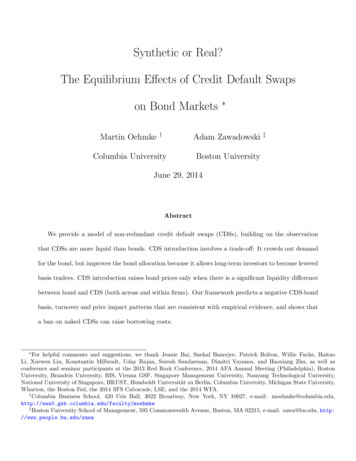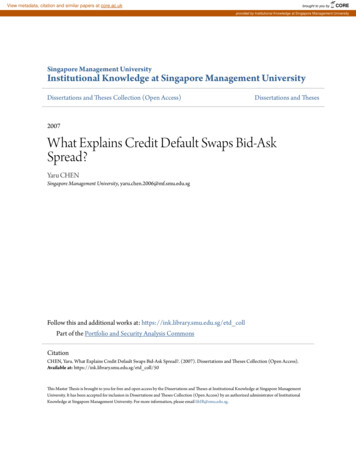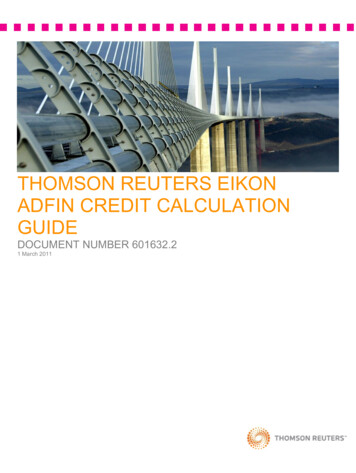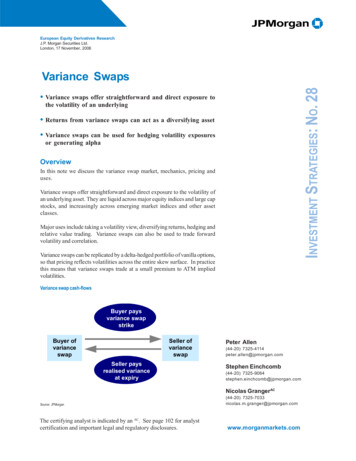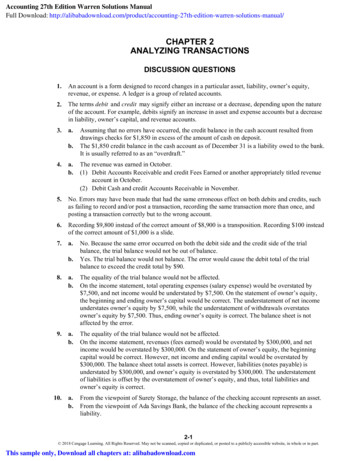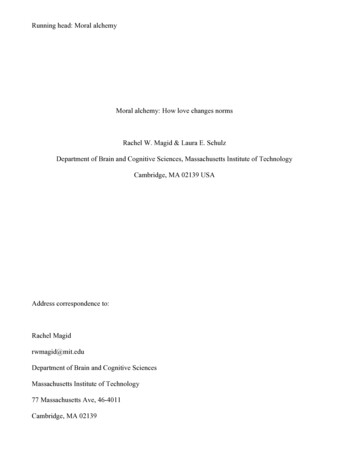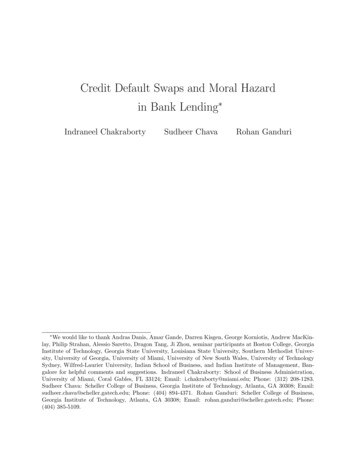
Transcription
Credit Default Swaps and Moral Hazardin Bank Lending Indraneel Chakraborty Sudheer ChavaRohan GanduriWe would like to thank Andras Danis, Amar Gande, Darren Kisgen, George Korniotis, Andrew MacKinlay, Philip Strahan, Alessio Saretto, Dragon Tang, Ji Zhou, seminar participants at Boston College, GeorgiaInstitute of Technology, Georgia State University, Louisiana State University, Southern Methodist University, University of Georgia, University of Miami, University of New South Wales, University of TechnologySydney, Wilfred-Laurier University, Indian School of Business, and Indian Institute of Management, Bangalore for helpful comments and suggestions. Indraneel Chakraborty: School of Business Administration,University of Miami, Coral Gables, FL 33124; Email: i.chakraborty@miami.edu; Phone: (312) 208-1283.Sudheer Chava: Scheller College of Business, Georgia Institute of Technology, Atlanta, GA 30308; Email:sudheer.chava@scheller.gatech.edu; Phone: (404) 894-4371. Rohan Ganduri: Scheller College of Business,Georgia Institute of Technology, Atlanta, GA 30308; Email: rohan.ganduri@scheller.gatech.edu; Phone:(404) 385-5109.
Credit Default Swaps and Moral Hazardin Bank LendingAbstractWe analyze whether introducing Credit Default Swaps (CDSs) on a borrower’sdebt leads to lender moral hazard around covenant violations, wherein lendingbanks can terminate or accelerate the loan. Using a regression discontinuitydesign, we show that CDS firms, including those with agency problems, do notdecrease their investment after covenant violations. However, they pay a higherloan spread, perform poorly, but do not go bankrupt at a higher rate whencompared with non-CDS firms that violate covenants. These results are magnifiedwhen lenders have weaker incentives to monitor and suggest that introducingCDSs misaligns incentives between lenders and borrowers.JEL Code: G21, G31, G32.Keywords: Credit Default Swaps, Bank Loans, Moral Hazard, Covenant Violation,Empty Creditor Problem.
1IntroductionCredit Default Swaps (CDSs) are a relatively new financial instrument that allow lenders toreduce exposure to the credit risk of their borrowers. Credit risk transfer, through a CDS,can be used to hedge on-balance sheet asset credit risk. Commercial banks and other lendersare natural buyers of CDS protection to mitigate credit risk which helps free up regulatorycapital,1 diversify risk, and potentially increase credit supply to firms (Gorton and Haubrich,1987; Pennacchi, 1988; Bolton and Oehmke, 2011; Saretto and Tookes, 2013). On the flipside, credit risk transfer through a CDS can reduce the incentives of banks to screen andmonitor their borrowers, even though they still retain control rights2 (Demarzo and Duffie,1999; Parlour and Plantin, 2008). This separation of cash flow exposure and control rightscould potentially give rise to an even stronger form of incentive misalignment, the emptycreditor problem (Hu and Black, 2008; Bolton and Oehmke, 2011; Subrahmanyam, Tang,and Wang, 2014).In this paper, we focus on the private debt market to study whether the initiation of CDStrading on borrowers’ debt misaligns incentives between lenders and borrowers. Covenantviolations and the consequent renegotiation between banks and borrowers provide an idealsetting to understand whether lender moral hazard exists when lenders can easily engagein credit risk transfer. Covenant violations give creditors contractual rights similar to thosein the case of payment defaults – rights include requesting immediate repayment of theprincipal and termination of further lending commitments – enhancing the bargaining powerof lenders vis-á-vis the borrowers (Chava and Roberts, 2008; Nini, Smith, and Sufi, 2009). If1For instance, the Basel II regulation permits using a CDS as a hedge against loan credit risk if the CDSreference obligation (typically a bond) is junior to the loan being hedged2Banks may now originate a loan, hold the loan on their balance sheet, and continue to service the loanwithout being exposed to the borrowing firm’s prospects. Servicing includes monitoring the borrower andenforcing the covenants, even though economic exposure to credit risk is passed on to the credit default swapinsurance provider.1
the lenders are indeed empty creditors and intend to impose harsher renegotiated loan termsto extract rents or if they intend to push borrowers into bankruptcy, borrowers’ covenantviolations give lenders an ideal opportunity to do so. Covenant violations also allow us toemploy a regression discontinuity design to help with identification.There are potential countervailing forces against moral hazard in the private debt marketthat may not be as relevant for public bond holders. First, banks, in contrast to publicbond holders, may face reputation costs if they push borrowers into inefficient bankruptcyor liquidation. These reputation costs are two-fold and are not directly modeled in theone period setup of Bolton and Oehmke (2011). One cost that lead-lenders face is thedamage to their reputation in the loan syndication market in the event that the borrowerfiles for bankruptcy (Gopalan, Nanda, and Yerramilli, 2011). In addition, in a competitivelending market, a lender with a reputation of being an empty creditor, who imposes harshrenegotiated loan terms or pushes borrowers into bankruptcy, would be at a disadvantage.Moreover, lenders risk losing all the relationship-specific information and future profits inthe case of borrower bankruptcy. These reputation costs may be large enough to discouragebanks from engaging in the aforementioned exploitative behavior in a multi-period setting.Thus, whether or not lender moral hazard exists in the private debt market, is ultimatelyan empirical question that we address in this paper.In order to answer this question, we first analyze changes in corporate policies of borrowers conditional on covenant violations in a regression discontinuity framework. Chava andRoberts (2008) and Nini, Smith, and Sufi (2009) document that lenders in the private debtmarket use their bargaining power to influence borrowers’ corporate policies after a covenantviolation, and this type of creditor governance improves firm value (Nini, Smith, and Sufi,2012). On the other hand, banks that hedge borrower exposure with CDSs, may be prone tomoral hazard and not expend costly effort in negotiating and influencing firm policies. We2
find that borrowers with CDS trading on their debt do not reduce their investment after theircovenant violations. This is in contrast to firms without CDSs which experience a significantreduction in firm investment. These results are broadly supportive of lender moral hazardand suggest that lenders do not expend much effort on influencing investment policies ofborrowers after covenant violations when borrowers have CDS trading on their debt.In the absence of availability of data on the exact net credit risk exposure of the lender tothe borrower, we use other measures of lenders’ propensity to engage in credit risk transferand consequent lender moral hazard. We consider three proxies: banks’ purchase of creditderivatives, their securitization activity, and their reliance on non-interest income. Consistent with our hypotheses, when lenders are more likely to lay off credit risk and exhibitmoral hazard (i.e., banks that engage in credit risk transfer through credit derivatives orsecuritization, or rely more on non-interest income), we find that covenant violations do nothave a material impact on a firm’s investment policies.A potential alternative explanation for our results could be that investment projects offirms with CDSs are more valuable and, hence, investment is not cut even after covenantviolations. Chava and Roberts (2008) show that there is a significantly larger decrease in firminvestment post covenant violation when borrowers have information asymmetry or agencyconflicts (as proxied by cash holdings and the length of the relationship with the lender),highlighting that inefficient investment is reduced. In contrast, we find that when lenders canpurchase CDSs on borrowers, there is no significant drop in investment even when borrowersare more exposed to information asymmetry and agency problems. These results providefurther support to credit risk transfer through CDS causing lender moral hazard.We next consider the result of debt renegotiations after a borrower violates a covenantand when the borrower has a CDS trading on its debt. As discussed before, after the covenantviolations, creditors can request immediate repayment of the principal and terminate further3
lending commitments. Alternatively, creditors can use their additional bargaining power andextract higher spreads on loans extended consequent to the covenant violation. Consistentwith the argument that the availability of credit derivatives on the borrower’s debt increasesthe lender’s outside options (Bolton and Oehmke, 2011) and, hence, their bargaining powervis-á-vis the borrower, we find that after technical covenant violations, lenders charge higherspreads on renegotiated loans of borrowers with a traded CDS. These results suggest that theavailability of CDS on borrowers induces lender moral hazard, where lenders do not expendcostly effort to influence firm policies that increase firm value, but extract rents using theirstronger bargaining power.We next examine the effect of lender intervention on the stock returns of the borrowingfirm after covenant violation in the presence of a traded CDS on the firm’s debt. Fornon-CDS firms, we find that after a covenant violation, the actions taken by creditors toinfluence borrowers’ policies increase the value of the firm (Nini, Smith, and Sufi, 2012).However, for firms with traded CDSs, the post covenant violation cumulative abnormalreturns are not significantly different from zero and are negative in the long-run, indicatingdeteriorating firm performance. Consistent with this evidence, we find that firms with tradedCDSs on their debt are more likely to experience a credit rating downgrade consequent to acovenant violation. Overall, these results again support the existence of lender moral hazardwherein the lender doesn’t expend costly effort to influence firm policies to improve firmvalue. Instead, lenders renegotiate higher loan spreads post-covenant violation using theirenhanced bargaining power. Consequently, firm performance deteriorates as evidenced bycredit rating downgrades and lower stock returns.One implication of severe moral hazard problems is that CDS trading may lead to higherborrower bankruptcies (see Bolton and Oehmke, 2011; Subrahmanyam, Tang, and Wang,2014). Our results from a Cox proportional hazards model of the survival time of the firm4
after covenant violation suggests that CDS firms are neither more nor less likely to make adistressed exit or go bankrupt after a covenant violation than firms without CDS.3 Theseresults indicate that banks may not be actively causing firm bankruptcies due to overinsurance (empty creditor problem). Rules regarding risk-weighting of bank assets, such as thoseprescribed by Basel Accords, suggest why banks may not overinsure against borrowing firms.The risk weights, determined based on the credit rating of a borrower, can be substitutedby those of the CDS protection seller when the CDS is used to hedge credit exposure fromthe borrower. Typically, as the CDS protection/insurance seller is better rated than theborrower, it leads to lower risk weights on the credit exposure. However, if CDS purchaseslead to overinsurance, they are deemed speculative assets and receive higher risk weights.Thus, overinsurance can be quite costly for banks. Banks that do not overinsure are lesslikely to be empty creditors. Another potential reason could be the inability of banks, whichare arguably more informed, to overinsure (as opposed to partially insure) against the borrower due to increased adverse selection problems making any marginal credit protectionexpensive, especially after a covenant violation.Finally, we explore whether these ex-post lender moral hazard problems in the presenceof CDS trading on borrowers are consistent with ex-ante loan announcement returns. Theoretically, Diamond (1984) suggests that bank monitoring improves firm value. Empiricalevidence that bank credit line announcements indeed generate positive abnormal borrowerreturns is presented in Mikkelson and Partch (1986), James (1987), Lummer and McConnell(1989), and Billett, Flannery, and Garfinkel (1995) among others. If capital markets anticipate lender moral hazard in the presence of CDS trading and, consequently, lower lendermonitoring (see Demarzo and Duffie, 1999; Parlour and Plantin, 2008), then loan announcement returns for a firm with CDSs, should be relatively lower than returns for firms without3Following Gilson (1989) and Gilson, John, and Lang (1990), firms are identified as distressed if they arein the bottom 5% of the universe of firms in the Center for Research in Security Prices (CRSP) on the basisof the past three-year cumulative return.5
CDSs. In the absence of any agency problems between banks and firms, the loan announcement returns of firms with CDSs should be statistically indistinguishable from firms withoutCDSs. We find that loan announcement returns for CDS firms are muted and not statistically different from zero. However, the loan announcement returns for non-CDS firms arepositive and significant, which is in line with the previous studies.Overall, our results complement and enrich our understanding of the impact of CDSson the credit risk of the borrowers. Subrahmanyam, Tang, and Wang (2014) show thatCDS introduction leads to a higher incidence of bankruptcy and credit rating downgradesfor firms. However, they do not distinguish between public and private debt. In a relatedpaper, Danis (2012) analyzes out-of-court restructurings of public debt and shows that firmswith CDSs face difficulties with reducing debt out-of-court, thus increasing the likelihoodof future bankruptcy. Our results suggest that lenders in the private market behave verydifferently from public bond holders after covenant violations. In contrast to public debtholders, reputational concerns, future lending and non-lending business from establishedrelationships, and lower debt renegotiation frictions due to concentrated ownerships are afew of the factors that can mitigate such severe moral hazard concerns in the private debtmarket.Our paper is related to work that examines the impact of credit transfer mechanismson lenders.4 However, CDSs are not the only mechanism that lenders have to reduce theirexposure to the borrowers. Some other possibilities are loan syndication, loan sales, and loansecuritization. In the context of loan sales, Dahiya, Puri, and Saunders (2003) empiricallyshow that firms whose loans are sold by their banks suffer negative stock returns, and suggestthat a loan sale conveys the selling bank’s private negative information on the borrower tothe market. As Parlour and Winton (2013) discuss, the broad difference between loan sales4The CDS market has grown quickly to an outstanding notional value as high as 5 Trillion U.S. dollars,or approximately 15% of the total over the counter derivative markets in the 2007–2008 period.6
and a CDS purchase on a loan is that in the former cash flows are bundled with controlrights, while in the latter they are not.Drucker and Puri (2009) show that sold loans have significantly more covenants than loansthat are not sold, reducing the financial flexibility of the borrowers. However, Wang and Xia(2014) show that banks impose less restrictive covenants in anticipation of securitization. Ina recent paper, Shan, Tang, and Winton (2015) find that debt covenants are less strict ifCDS contracts exist on the borrowing firm’s debt at the time of loan initiation. Interestingly,we find that, even ex-post, lenders do not influence CDS firms to reduce their investmentafter covenant violations. Securitization and hedging borrower exposure with a CDS havevery different economic implications for lenders.5 Our results contribute to this literatureand highlight lender moral hazard when banks maintain control rights (but not economicexposure).Our work also relates to the literature on the special nature of banks as informationproducers and monitors.6 We show that the market reaction to a loan announcement isinsignificant when there is a potential for lender moral hazard in the presence of CDS tradingon the borrower’s debt. However, the loan announcement returns for non-CDS firms arepositive and significant, consistent with the previous studies.The remaining sections are organized as follows. Section 2 discusses sources of data andsummary statistics. Section 3 discusses our empirical specifications and results. Section 4concludes.5Also, as Wang and Xia (2014), among others, point out, generally loans of borrowing firms with highleverage, non-investment grade rating, and severe information problems are securitized. On the other hand,as Saretto and Tookes (2013) and our paper among others find, firms with CDSs traded against them are insimilar, if not in better, financial health than other firms.6Lummer and McConnell (1989) focus on the status of the lending relationship and find that new bankloans generate zero average abnormal returns, while loan renewals have a positive effect. The type of lenderalso matters. James (1987) finds that loans placed with banks have a higher announcement effect comparedto loans placed through private placements. In contrast, Preece and Mullineaux (1994) find a smaller returnfor bank loans. The findings of Billett, Flannery, and Garfinkel (1995) suggest that the quality of the lenderaffects the market’s perception of firm value.7
2Data2.1Data sources and sample selectionWe utilize five main datasets for our analysis: (i) Loan Pricing Corporation (LPC) Dealscandatabase; (ii) Credit Market Analysis (CMA) Datavision dataset; (iii) Bloomberg; (iv)Markit; (v) Consolidated Financial Statements for Bank Holding Companies (FR Y-9C)and Bank Call Report data. We obtain firm-quarter level financial data from COMPUSTATand equity return-related information from the CRSP.Loan information is extracted from the Dealscan database. The basic unit of loansreported in Dealscan is a loan facility. Loan facilities are grouped into packages. Packagesmay contain various types of loan facilities for the borrower. Loan information such as loanamount, maturity, type of loan, and other information, is reported at the facility level. Thedatabase consists of private loans made by bank and non-bank lenders to U.S. corporations.The Dealscan database contains the majority of all commercial loans issued in the U.S. Weconstruct our covenant violation sample following Chava and Roberts (2008) for the periodbetween 1994 and 2012.7 We focus on loans of non-financial firms with covenants writtenon current ratio, net worth, or tangible net worth, as these covenants are more frequent andthe accounting measures used for these covenants are unambiguous, standardized and lesssusceptible to manipulation.The data on the timing of CDS introduction is obtained from three separate sources:Markit, CMA Datavision, and Bloomberg. The CMA Datavision database collects datafrom 30 buy-side firms which consist of major investment banks, hedge funds, and assetmanagers. Mayordomo, Pea, and Schwartz (2014) compare multiple CDS databases, namelyGFI, Fenics, Reuters, EOD, CMA, Markit, and JP Morgan, and find that the CDS quotes in7The covenant sample begins in 1994 as the information on covenants is limited before that period in theDealscan database.8
the CMA database lead the price discovery process. The CMA database is widely used amongfinancial market participants. We use the CMA database to identify all firms for which weobserve CDS quotes on their debt. To further ensure the accuracy of CDS initiation dateson a firm, we augment the CMA database with the CDS data from Bloomberg and Markit.We take the earliest quote date from those three databases as the first sign of active CDStrading on a firm’s debt.As discussed later, our primary variables of interest in the combined dataset are (i) anindicator that shows if the firm violates a financial covenant, and (ii) an indicator thatshows if the firm has outstanding CDS trades in the corresponding quarter. We do not haveaccess to data regarding the exact firms against which lending banks protect themselvesusing CDSs. However, since CDS protection can only be obtained for firms with tradedCDS, we divide firms based on traded CDS. We use the lead bank’s Y9C and call reportdata to identify which lenders are active in the credit derivatives market. Arguably, moststock market participants and investors also may not have access to information on whichspecific bank loans are protected with a CDS. Hence, we believe that our analysis basedon the credit derivative exposure of the bank and CDS trading for a firm is justified froma market investor’s point of view. This is especially true when we try to assess the stockmarket reaction to loan announcements and covenant violations.2.2Descriptive statisticsTable I summarizes the statistics for the loan announcement sample. Loan agreements aresignificant external financing events: the median loan or commitment size is 31% of the firm’stotal assets, which also implies that the median loan announcer is not a very large firm. Themedian maturity of a loan is approximately four years. Panel B of Table I summarizes thenumber of loan announcements along with the mean size of the loan each year. There are9
about 1,200 loan announcements per year, which is consistent with previous studies. Weobserve that the number of loans issued increased from 1990 to 1997, before declining andplateauing thereafter. Since the recent financial crisis, the number of loans issued per yearhas almost halved. The increasing trend in the earlier part of the sample may be due toDealscan’s increasing coverage of issued loans over time. Panel B of Table I also showsthat the average size of loan announcements has also increased over the years. There are3,074 loan announcements for 507 unique firms where the borrowing firms have traded CDScontracts. On the other hand, there are 24,375 loan announcements for 5,962 unique firmswhen the borrowing firms have not traded CDS contracts. Table I also shows that themedian loan size for firms that have CDS contracts traded is larger than the average loansize for firms that do not have CDS contracts traded. This difference in loan size leads usto specifically control for loan size in the latter part of the analysis.Table II, Panel A summarizes the statistics for the current ratio and net worth covenantsamples from 1994 to 2012. The current ratio and net worth samples consist of all firmquarter observations of non-financial firms in the COMPUSTAT database. These two samples are further divided based on whether a firm-quarter observation is determined to be incovenant violation (denoted by “Bind”) or not in covenant violation (denoted by “Slack”)for the corresponding covenant. Panel B displays the same set of firm-quarter observationssplit by firms with CDSs and without CDSs issued against them. The outcome variablesand control variables used in the analysis for changes in firm characteristics when a covenantviolation occurs are defined in the Appendix section. The distributions of the covenant violations and the control variables are in line with data used in previous studies (see Chavaand Roberts, 2008 and Nini, Smith, and Sufi, 2012).10
3Empirical resultsThis section provides evidence regarding the existence of lender moral hazard in the presenceof CDS trading on a borrowing firm’s debt. It also tests if an empty creditor problem exists,and whether markets anticipate lender moral hazard. Sections 3.1, 3.2, and 3.3 test for moralhazard based on (i) lender intervention in the firm’s operations, (ii) loan renegotiations aftercovenant violation, and (iii) the realized stock market returns in the post covenant violationperiod respectively. Section 3.4 tests for the presence of an empty creditor problem wherebanks can overinsure and cause a higher rate of firm bankruptcies by studying firm exithazard rates post covenant violation. Finally, Section 3.5 tests whether capital marketsanticipate and discount for the potential agency problems by comparing the stock marketreturns to the loan announcement conditional on whether or not CDS trades against a firm’sdebt.3.1CDS and Capital Expenditure After Covenant ViolationsFinancial covenant violations provide an ideal setting for studying agency problems thatbanks face in the presence of CDSs. Covenant violations give creditors contractual rightssimilar to those in the event of payment defaults, such as the right to request immediaterepayment of the principal and terminating further lending commitments. Such rights provide creditors with a sudden increase in bargaining position post-violation. Hence, if agencyproblems between lenders and borrowers exist, they should manifest after covenant violation.Granting waivers for a violation to a borrowing firm requires banks to investigate thefirm’s current condition, and its future prospects, and then handle each waiver on a caseby-case basis. This requires the lending bank to exert effort at a significant cost. Hence, ifa bank hedges or reduces its exposure to a firm through CDS trading, and the firm violates11
a covenant, the bank may not have economic incentives to take corrective actions. Totest for such lender moral hazard in the presence of CDS trading, we follow the regressiondiscontinuity approach in Chava and Roberts (2008).The identification is based on comparing firms just around the contractually writtencovenant violation threshold. We compare the average treatment effects (ATE) of firms thatviolate a covenant and have a traded CDS, with firms that violate a covenant and do nothave a traded CDS. Chava and Roberts (2008) have shown that after covenant violation,creditors intervene and firm investment is reduced significantly. Nini, Smith, and Sufi (2009)show that such intervention helps the firm regain financial strength over time, helping equityholders as well. If banks with CDS protection intervene less in firm policy, then we shouldsee smaller corrective changes, resulting in smaller drops in investment, for firms with CDSstraded against their debt than for firms without.The empirical specification is as follows, where i is the subscript to denote a specific firm,and subscript t represents time quarter:Investmentit α β1 d Bindit 1 d CDSit 1 β2 d Bindit 1(1) β3 d CDSit 1 β4 Xit 1 ηi δt εit ,where Investmentit is the ratio of the capital expenditures to the capital in the beginning ofthe period. Our main variables of interest is the interaction term d Bindit 1 d CDSit 1 .d Bindit 1 is an indicator variable equal to one if a firm i in quarter t 1 is in covenant violation and zero otherwise. Similarly, d CDSit 1 is an indicator variable equal to one if thereis a traded CDS contract for a firm i in quarter t 1. The coefficient β1 captures the averagedifference in investment between a firm with a traded CDS and a firm without a traded CDS,after covenant violation. Coefficient β2 captures the ATE of covenant violation for the firmsthat do not have a traded CDS. Xit 1 is a vector of control variables to control for potential12
differences in dynamic firm characteristics that affect firm investment. ηi denotes firm fixedeffects and δt estimates year-quarter fixed effects to control for unobserved heterogeneityacross firms and time. Detailed variable definitions of the dependent variable and all thefirm controls included in the regression specifications are provided in the Appendix.Table III, Panel A reports the results. The first three columns utilize the full datasetand the last three columns conduct the analysis using the regression discontinuity sample.The regression discontinuity sample limits the sample of observations to 30% of the relativedistance around the covenant violation boundary. Columns (2), (3), (5), and (6) includefirm level characteristics, and Columns (3) and (6) also include the distance from covenantviolation threshold as additional controls.The negative and statistically significant coefficients that we find on the d Bind indicatorvariable confirm the findings of Chava and Roberts (2008), who show that firms face asignificant reduction in investment after a covenant violation due to creditor intervention.The positive coefficient on the interaction term d Bind d CDS shows that firms whichviolate a covenant and have a CDS traded do not have as large a decrease in investment.In fact, adding the coefficients on d Bind and d Bind d CDS, we note that the net effectof violating a covenant on firm investment is statistically indistinguishable from zero forfirms with traded CDSs. The results hold through all six specifications. This supports thehypothesis that in the presence of CDS trading, which allows lending banks to reduce creditexposure to borrowing firms, banks do not intervene in changing firm investment policy aftergaining control post covenant violation.For a visual representation, Figure 1 plots firm investment with respect to the distanceof the firm from the covenant violation threshold.8 We consider two types of covenants, networth and current ratio, and use the tighter of the two covenants when both are present to8We also plot the polynomial fit for firm investment versus firm distance to covenant violation in theappendix section in Figure B.1.13
calculate the distance to covenant violation. The top panel reports the relationship betweenfirm investment and the distance to covenant violation for firms which do not have CDSstraded against
Credit risk transfer, through a CDS, can be used to hedge on-balance sheet asset credit risk. Commercial banks and other lenders are natural buyers of CDS protection to mitigate credit risk which helps free up regulatory capital,1 diversify risk, and potentially increase credit supply to rms (Gorton and Haubrich,
